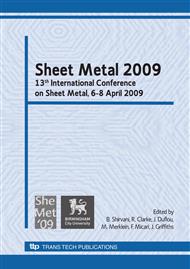[1]
R.R. Boyer: An overview on the use of titanium in the aerospace industry. Materials Science and Engineering A213 (1996), p.103.
Google Scholar
[2]
F.H. Froes, H. Friedrich, J. Kiese, D. Bergoint: Titanium in the family automobile: the cost challenge. JOM, February, Vol. 40 (2004).
DOI: 10.1007/s11837-004-0144-0
Google Scholar
[3]
Fuh-Kuo Chen, Kuan-Hua Chiu: Stamping formability of pure titanium sheets. Journal of Materials Processing Technology Vol. 170 (2005), p.181.
DOI: 10.1016/j.jmatprotec.2005.05.004
Google Scholar
[4]
Joji Satoh, Manabu Gotoh, Yasuharu Maeda: Stretch-drawing of titanium sheets. Journal of Materials Processing Technology, Vol. 139 (2003), p.201.
DOI: 10.1016/s0924-0136(03)00220-6
Google Scholar
[5]
M. Yamada: An overview on the development of titanium alloys for non-aerospace application in Japan. Materials Science and Engineering A 213(1996), p.8.
Google Scholar
[6]
R. Boyer, G. Welsch, E.W. Collings: Materials Properties Handbook: Titanium Alloys, ASM International, Materials Park, OH (1994).
Google Scholar
[7]
D.M. Brunette, P. Tengvall, M. Textor, P. Thomson: Titanium in medicine. Springer-Verlag Berlin Heidelberg, Niemcy (2001).
Google Scholar
[8]
V.R. Jablonkov, J.R. Wood, B.G. Drummond, N.P. Hoskinson: Processing and properties of Ti38-644 alloy for titanium automotive suspension springs. Proceedings of the 10th World Conference Ti-2003 Science and Technology Vol. 5 (2004), p.3035.
Google Scholar
[9]
B.J. Marquardt, J.R. Wood, B.G. Drummond: Processing and properties of Alvac®38-644 alloy for titanium suspension springs. OUTLOOK, Special edition Vol. 23 (2002), p.4.
DOI: 10.4271/2002-01-2129
Google Scholar
[10]
J.A. Disegi: Titanium alloys for fracture fixation implants. Injury, Int. J. Care Injured Vol. 31, (2000), S-D14-17.
DOI: 10.1016/s0020-1383(00)80017-0
Google Scholar
[11]
B. Gunawarmana, Mitsuo Niinomia, Toshikazu Akahoria, Junichi Takedaa, Hiroyuki Toda: Mechanical properties of Ti-4. 5Al-3V-2Mo-2Fe and possibility for healthcare applications. Materials Science and Engineering C 25, (2005), p.296.
DOI: 10.1016/j.msec.2004.12.012
Google Scholar
[12]
M. Niinomi: Recent research and development in titanium alloys for biomedical applications and healthcare goods. Science and Technology of Advanced Materials Vol. 4, (2003), p.445.
DOI: 10.1016/j.stam.2003.09.002
Google Scholar
[13]
H.J. Rack, J.I. Quazi: Titanium alloys for biomedical applications. Materials Science and Engineering C 26 (2006), p.1269.
Google Scholar
[14]
E.B. Taddei, V.A.R. Henriques, C.R.M. Silva, C.A.A. Cairo: Production of new titanium alloy for orthopedic implants. Materials Science and Engineering C 24 (2004), p.683.
DOI: 10.1016/j.msec.2004.08.011
Google Scholar
[15]
N. Alberti, L. Fratini: Innovative sheet metal forming processes: numerical simulations and experimental tests. Journal of Materials Processing Technology Vol. 150 (2004), p.2.
DOI: 10.1016/j.jmatprotec.2004.01.048
Google Scholar
[16]
G. Gantar, T. Pepelnjak, K. Kuzman: Optimization of sheet metal forming processes by the use of numerical simulations. Journal of Materials Processing Technology Vol. 130-131 (2002), p.54.
DOI: 10.1016/s0924-0136(02)00786-0
Google Scholar
[17]
A.E. Tekkaya: State-of-art of simulation of sheet metal forming. Journal of Materials Processing Technology Vol. 103 (2000), p.14.
DOI: 10.1016/s0924-0136(00)00413-1
Google Scholar
[18]
M. Tisza: Numerical modelling and simulation in sheet metal forming. Journal of Materials Processing Technology Vol. 151 (2004), p.58.
DOI: 10.1016/j.jmatprotec.2004.04.009
Google Scholar
[19]
H. Yang, M. Zhan, Y.L. Liu, F.J. Xian, Z.C. Sun, Y. Lin, X.G. Zhang: Some advanced plastic processing technologies and their numerical simulation. Journal of Materials Processing Technology Vol. 151 (2004), p.63.
DOI: 10.1016/j.jmatprotec.2004.04.015
Google Scholar
[20]
J. -M. Liu, S. -S. Chou: Study on the microstructure and formability of commercially pure titanium in two-temperature deep drawing. Journal of Materials Processing Technology Vol. 95 (1999), p.65.
DOI: 10.1016/s0924-0136(99)00108-9
Google Scholar
[21]
Y. Kosaka, S.P. Fox: Recent development of titanium and its alloys in automotive exhaust applications. Proceedings of the Symposium: Titanium Alloys for High Temperature Applications. Edited by: M.W. Peretti, D. Eylon, U. Habel, G. C. Keijzers. TMS 2006 Annual Meeting in San Antonio, Texas, USA, March 12-16, (2006).
Google Scholar
[22]
R. Melechov, K. Tubielewicz, W. Błaszczuk: Titanium and its alloys. (in Polish) Ed. Częstochowa University of Technology, Poland (2004).
Google Scholar
[23]
A. Bylica, J. Sieniawski: Titanium and its alloys (in Polish). PWN, Warsaw -Poland (1985).
Google Scholar
[24]
M. Gierzyńska-Dolna: Tribological properties of titanium alloys (in Polish). Proceedings of the 2nd Symposium: Titanium and its alloys. Processing and application. Poland - Krakow, (1992), p.5. 1.
Google Scholar
[25]
K. Mori, T. Murao, Y. Harada: Multi-stage cold deep drawing of long pure titanium cups using coloured sheets for prevention of seizure. Annals of the CIRP Vol. 52-1 (2003), p.237.
DOI: 10.1016/s0007-8506(07)60574-5
Google Scholar
[26]
L. Fratini, S.L. Casto, E.L. Valvo: A technical note on experimental device to measure friction coefficient in sheet metal forming. Journal of Materials Processing Technology Vol. 172 (2006), p.16.
DOI: 10.1016/j.jmatprotec.2005.08.008
Google Scholar
[27]
J. Adamus: Tribological problems in sheet-titanium forming process, in Polish, Tribologia Vol. 2 (2008) p.15.
Google Scholar
[28]
ADINA R& D, Inc.: Theory and modeling guide. Vol. 1: ADINA Solids & Structures Report ARD (2005).
Google Scholar
[29]
S.P. Keeler, W.A. Backofen: Plastic instability and fracture in sheets stretched over rigid punches. Trans. Am. Soc. Met. Vol. 56 (1963), p.25.
Google Scholar
[30]
G.M. Goodwin: Application of strain analysis to sheet metal forming problems in the press shop. Society of Automotive Engineers, Paper 680093 (1968).
DOI: 10.4271/680093
Google Scholar
[31]
J. Adamus: Simulation of the sheet-metal forming process with changeable holding force and different frictional resistance. International Journal of Applied Mechanics and Engineering, 9, special issue: ITC 2004, (2004), p.241.
Google Scholar
[32]
D. Dörmann, G. Saum, W. Wall: New press concept fort he PBH processes. Proceedings of the International Conference Net-shape sheet metal forming, 13th May, 2005, Poznań-WąsowoPoland, (2005), p.225.
Google Scholar
[33]
P. Lacki, J. Adamus: An influence of the holding force on the sheet-metal forming process. Conference Proceedings of the International Conference Net-Shape Sheet Metal Forming concluding the international project INETFORSMEP financed by the European Union 13th May 2005 Poznań-Wąsowo- Poland, (2005).
DOI: 10.1063/1.2011205
Google Scholar


